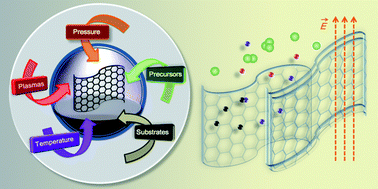It is impossible to keep up with the torrent of papers on our wonder material. So let's just look at a few from the past few days.
How to make vertically oriented graphene nanosheets
The journal Nanoscale has just published a paper, a review article no less, with the title “Plasma-enhanced chemical vapor deposition synthesis of vertically oriented graphene nanosheets”. All behind a paywall, of course.The abstract gives a good idea of what you will get if you cough up your £36. “This paper attempts to summarize the state-of-the-art research on [plasma-enhanced chemical vapour deposition] growth of [vertically oriented graphene] nanosheets to provide guidelines on the design of plasma sources and operation parameters, and to offer a perspective on outstanding challenges that need to be overcome to enable commercial applications of VG.”
It comes with an interesting picture:

Pity there isn’t a caption. Guess you have to buy the paper for that.
More in Nanoscale
Nanoscale also bills several other graphene papers in the same issue:Another paper turns up in the journal's roster of This week’s HOT articles
In theory
Nice to see the theoreticians are on the case. This in Phys. Rev. Lett. from folks at the Institute for Theoretical Physics at the University of Regensburg.Spin-Orbit Coupling in Hydrogenated Graphene offers “First-principles calculations of the spin-orbit coupling in graphene with hydrogen adatoms in dense and dilute limits”. So now you know.
Laser peels off graphene layers
Thanks to the excellent regime over at IoP Publishing, everyone has 30 days in which to grab the paper Thinning of large-area graphene film from multilayer to bilayer with a low-power CO2 laser from the journal Nanotechnology, a constant source of new papers on graphene. The abstract tells us that “Bilayer graphene has attracted a great deal of attention for many electronic and optical applications”.This paper describes a way of turning the multilayer graphene you get when you make graphene with chemical vapour deposition into a ‘bilayer’ material. This isn’t the first time that people have used layers to thin down graphene, but this time, the researchers claim, the approach “enables high-efficiency thinning of large-area graphene film whilst using a significantly reduced power density and an increased laser beam diameter”.
There’s an interesting connection to Manchester University. This time it isn’t the world famous graphene group that chipped in, but the Laser Processing Research Centre. The graphene expertise seems to have come from Tsinghua University in Beijing.
Graphene on silicon
Another interesting paper over at IoPP is in the open access publication New Journal of Physics, so no need to rush for this one. Strongly confined gap plasmon modes in graphene sandwiches and graphene-on-silicon comes from Imperial College. The researchers have been slapping payers of graphene on top of one another, or, as they put it, “two infinitely long graphene ribbons vertically offset by a gap”.To demonstrate the relevance of their work, the authors report “an unprecedented level of confinement of a terahertz wave of nearly five orders of magnitude when a graphene ribbon is placed on top of a highly doped silicon substrate”. They add that these phenomena and semiconducting substrates “could be the building blocks for both graphene-based integrated optics and ultrasensitive sensing modalities”. Now it just needs someone to do the experiments to show that this is not a mad idea.
No comments:
Post a Comment